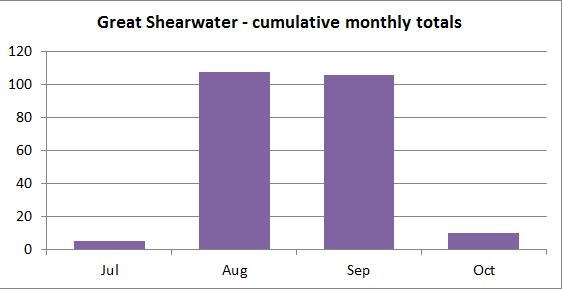Cory’s Shearwater
 Tuesday, December 28, 2010 at 5:34PM
Tuesday, December 28, 2010 at 5:34PM Calonectris diomedea
Erratic visitor.
The Cory’s Shearwater breeds in several places around the Mediterranean, in Portugal and on the sub tropical islands of the east Atlantic. It is migratory outside the breeding season, many then occurring in the Bay of Biscay, regularly penetrating as far as Cornwall and occasionally appearing in large numbers off the south west of Ireland.
It is an erratic visitor to Pembrokeshire waters, being first recorded from the Fishguard to Rosslare ferry on the 25th September 1965 by Jack Donovan. From then until 2007 a total of 86 birds have been logged. They were not recorded annually, being seen in 66 % of those years. The earliest was off the South Bishop on the 22nd February 1976, the latest off Strumble Head on the 29th November 1999. Otherwise the cumulative monthly totals were:

Most sightings involved single birds, with two in a day on five occasions, three once, five twice and the maxima of six in the Celtic Deep on the 26th September 1999 and seven off Strumble Head on the 15th August 1999. The largest incursion was in 1999 with a total of 26 bird days logged.
Considered by BWP as “equally satisfied with pelagic, offshore and inshore waters”, the fact that 78 % of Pembrokeshire sightings were made from the land, probably reflects the distribution of observer effort. A total of 14 of these were seen from Skokholm, Skomer, St Ann’s Head, South Bishop, Ramsey and St Govan’s Head, and 53 from Strumble Head. The hours of observation expended from the land greatly exceeded the time spent looking in offshore waters.
Offshore sightings were of singles from the Fishguard to Rosslare ferry, from a small craft west of Grassholm and from another boat north of Porth Gain, five from the Pembroke to Rosslare ferry and 11 from shark-fishing vessels in the Celtic Deep.
Cory’s Shearwaters have been seen in Pembrokeshire waters in a variety of weather conditions, with winds from all directions and ranging from calm through moderate winds to full gale force, making their appearance unpredictable.
It is not known to what degree the races Calonectris diomedia deomedia and C.d. borealis are involved in the Pembrokeshire record.
Graham Rees
(Covers records up to and including 2007)
References
CRAMP. S. (Editor), 1977 – 1994. Handbook of the Birds of Europe, the Middle East and North Africa : the birds of the Western Palearctic, Oxford University Press, 9 Vols.
 GHR,
GHR,  seabird,
seabird,  shearwater,
shearwater,  vagrant in
vagrant in  Cory's Shearwater
Cory's Shearwater 




